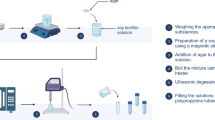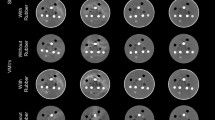Abstract
The aim of the present study is to obtain dose distributions of gel dosimeters at 6 and 18 MV photon energies and 6, 9, 12, 15, and 18 MeV electron energies using the GATE simulation program and to compare the resulting radiological features with the results experimentally obtained for liquid water and the international dose protocol suggested by the IAEA. Furthermore, in this study, the fast neutron removal cross-sections (ΣR) and attenuation lengths of gel dosimeters have been calculated. The effects on the absorbed dose distributions due to variation in the effective atomic number, mass attenuation coefficient, and effective photon energy are calculated for MAGIC, MAGAS, MAGAT, LMD1, LMD2, FAX, FXG, PAKAG formulations at irradiations with photon and electron beams. In the present study, mass attenuation coefficient values calculated for mono energies of 6 and 18 MV were compared with the values acquired by GATE, XCOM, PhyX-PSD, EpiXS, and XMuDat softwares for the same energies. In addition, spectrum values of the multi-energetic photon energies of 6 and 18 MV were drawn from the LINAC device database and introduced to GATE, and mass attenuation coefficient values of the gel dosimeters in the spectrum energy were calculated. In the 6 and 18 MV energy photon energy, MAGAS and FAX were found to have the lowest difference compared to water. Mean dose differences of MAGAS and FAX were obtained as 0.76 ± 0.69 and 1.74 ± 0.59, respectively. Mean dose differences of the gel dosimeters compared with water did not exceed 3% in both energy types. The study shows that, as a result of the simulation, software programs, the new approach, and theoretical calculations, it was found that the values obtained for \(\mathrm{effective atomic number}\) and mass attenuation coefficient were compatible with liquid water.

Similar content being viewed by others
References
C. Garibaldi, B.A. Jereczek-Fossa, G. Marvaso, S. Dicuonzo, D.P. Rojas, F. Cattani, A. Starzynska, D. Ciardo, A. Surgo, M.C. Leonardi, R. Ricotti, Recent advances in radiation oncology. Ecancer Med Sci. 11, 785 (2017)
V. Mariotti, A. Gayol, T. Pianoschi, F. Mattea, V. Vedelago, P. Perez, M. Valente, M. Alva-Sanchez, Radiotherapy dosimetry parameters intercomparison among eight gel dosimeters by Monte Carlo simulation. Radiat. Phys. Chem. 190, 1–12 (2022)
M. Valente, J. Vedelago, D. Chacon, F. Mattea, J. Velasquez, P. Perez, Water-equivalence of gel dosimeters for radiology medical imaging. Appl. Radiat. Isot. 141, 193–198 (2018)
T. Kron, J. Lehmann, P.B. Greer, Dosimetry of ionizing radiation in modern radiation oncology. Phys. Med. Biol. 61, 167–205 (2016)
Y. Watanabe, L. Warmington, N. Gopishankar, Three-dimensional radiation dosimetry using polymer gel and solid radiochromic polymer: from basics to clinical applications. World J. Radiol. 9, 112–125 (2017)
B. Farhood, G. Geraily, S.M.M. Abtahi, A systematic review of clinical applications of polymer gel dosimeters in radiotherapy. Appl. Radiat. Isot. 143, 47–59 (2019)
O. Moussous, T. Medjadj, A standard Fricke dosimeter compared to an ionization chamber used for dosimetric characterization of 60Co photon beam. Pol. J. Med. Phys. Eng. 22, 19–24 (2016)
C. Baldock, Y. Deene, S. De Doran, G. Ibbott, A. Jirasek, M. Lepage, K.B. McAuley, M. Oldham, L.J. Schreiner, Polymer gel dosimetry. Phys. Med. Biol. 55, R1–R63 (2010)
K. Adinehvand, F.N. Rahatabad, Monte-Carlo based assessment of MAGIC, MAGICAUG, PAGATUG and PAGATAUG polymer gel dosimeters for ovaries and uterus organ dosimetry in brachytherapy, nuclear medicine and Tele-therapy. Comput. Meth Prog Biomed. 159, 39–50 (2018)
L.J. Schreiner, Review of Fricke gel dosimeters. J. Phys. Conf. Ser. 3, 9–21 (2004)
M. Romero, M. Macchione, F. Mattea, M. Strumia, The role of polymers in analytical medical applications. A review. Microchem. J. 159, 105366 (2020)
P. Sellakumar, E.J.J. Samuel, S.S. Supe, Water equivalence of polymer gel dosimeters. Radiat. Phys. Chem. 76(7), 1108–1115 (2007)
G.S. Ibbott, Applications of gel dosimetry. J Phys. Conf Ser. 3, 58 (2004)
A. Kaşkaş Öztepe, T. Şahmaran, Determination of the radiological properties of materials A new approximation method for calculation of the mass attenuation coefficients. Appl Rad Isot. 187, 110340 (2022)
Andreo P. Burns DT, Hohlfeld K, Huq M, Kanai T, Laitano F, Smythe V, Vinckier S. 2006. Absorbed Dose Determination in External Beam Radiotherapy: An International Code of Practice for Dosimetry Based on Standards of Absorbed Dose to Water
J.H. Hubbell, S.M. Seltzer, Tables of X-Ray Mass Attenuation Coefficients and Mass Energy-Absorption Coefficients (National Institute of Standards and Technology, Gaithersburg, 1995)
M.J. Berger, J.H. Hubbell, XCOM: national institute of standards and technology. Gaithersburg 20899, 1987–1999 (1987)
M. Kurudirek, Water equivalence study of some phantoms based on effective photon energy effective atomic numbers and electron densities for clinical MV X-ray and Co-60 ℽ-ray beams. Nucl. Inst. Methods Phys. Res. A 701, 268–272 (2013)
S.R. Manohara, S.M. Hanagodimath, K.S. Thind, L. Gerward, On the effective atomic number and electron density: a comprehensive set of formulas for all types of materials and energies above 1 keV. Nucl. Instrum. Methods B. 266(18), 3906–3912 (2008)
Nowotny R. XMuDat: Photon attenuation data on PC. IAEANDS-195, 1998 Vienna, Austria. Available on https://www-nds.iaea.org/publications/iaea-nds/iaea-nds 0195.htm.
D.F. Jackson, D.J. Hawkers, X-ray attenuation coefficient of the elements and mixtures. Phys. Rep. 70, 169–233 (1981)
L.K. Zoller, Fast-neutron removal cross sections. Nucleonics 22, 128 (1964)
F.C. Hila, A.A. Astronomo, C.A.M. Dingle, J.F.M. Jecong, A.M.V. Javier-Hila, M.B.Z. Gili, C.V. Balderas, G.E.P. Lopez, N.R.D. Guillermo, A.V. Amorsolo, EpiXS: A Windows-based program for photon attenuation, dosimetry and shielding based on EPICS2017 (ENDF/B-VIII) and EPDL97 (ENDF/B-VI8). Radiat Phys Chem. 182, 109331 (2021)
M.G. El-Samrah, A.M. El-Mohandes, A.M. El-Khayatt, S.E. Chidiac, MRCsC: a user-friendly software for predicting shielding effectiveness against fast neutrons. Rad Phys Chem 182, 109356 (2021)
E. Şakar, Ö.F. Özpolat, B. Alım, M.I. Sayyed, M. Kurudirek, Phy-X / PSD: Development of a user friendly online software for calculation of parameters relevant to radiation shielding and dosimetry. Radiat. Phys. Chem. 166, 108496 (2020)
M.F. Kaplan, Concrete Radiation Shielding (Longman Scientific and Technology, Limited, Essex, London, 1989)
A.B. Chilton, R.E. Faw, J.K. Shultis, Principles of Radiation Shielding (Prentice Hall, Englewood Cliffs, 1984)
O. Moussous, Effective atomic number and electron density determination for fricke gel dosimeters using different methods. J. Med Phys. 47, 105–108 (2022)
H. Osman, H. Gümüs, Stopping power and CSDA range calculations of electrons and positrons over the 20 eV–1 GeV energy range in some water equivalent polymer gel dosimeters. Appl. Radiat. Isot. 179, 110024 (2022)
S.A.A. Aziz, W.N.W.A. Rahman, R. Abdullah, A.Z. Harun, A. Zakaria, Optimization of magat with formaldehyde gel dosimeter for dose evaluation. Sci Technol Conf 978, 1–922069 (2013)
T. Gorjiara, R. Hill, Z. Kuncic, S. Bosi, C. Baldock, Water equivalence of micelle gels for x-ray beams. J. Phys: Conf. Ser. 444, 012024 (2013)
A. Rashidi, S.M.M. Abtahi, E. Saeedzadeh, M.E. Akbari, A new formulation of polymer gel dosimeter with reduced32 toxicity: Dosimetric characteristics and radiological properties. Z Med Phys. 30(3), 185–193 (2020)
O.E. Duran-Nava, E.R. Torres-Garcia, R. Oros-Pantoja, J.O. Hernandez-Oviedo, Monte carlo simulation and experimental evaluation of dose distributions produced by a 6 MV medical linear accelerator. J. Phys: Conf. Ser. 1221, 012079 (2019)
T. Sahmaran, A. Kaskas, The effect of the trace elements concentrations on the cancerous and healthy tissues in radiotherapy. Int J Med Phys Clin Eng Rad Oncol 9, 110–124 (2020)
S. Sathiyan, M. Ravikumar, Absolute dose determination in high-energy electron beams: Comparison of IAEA dosimetry protocols. J. Med. Phys. Assoc. Med. Phys. 33, 108 (2008)
C. Santos, W. Santos, A. Perini, C. Valeriano, W. Belinato, L. Caldas, L. Neves, Evaluation of polymer gels using Monte Carlo simulations. Radiat. Phys. Chem. 167, 108234 (2020)
V.P. Singh, N.M. Badiger, Shielding efficiency of lead borate and nickel borate glasses for gamma rays and neutrons. Glass Phys Chem 41, 276–283 (2015)
Author information
Authors and Affiliations
Corresponding author
Additional information
Publisher's Note
Springer Nature remains neutral with regard to jurisdictional claims in published maps and institutional affiliations.
Rights and permissions
Springer Nature or its licensor (e.g. a society or other partner) holds exclusive rights to this article under a publishing agreement with the author(s) or other rightsholder(s); author self-archiving of the accepted manuscript version of this article is solely governed by the terms of such publishing agreement and applicable law.
About this article
Cite this article
Şahmaran, T. Evaluation of the radiological properties of gel dosimeters and some human tissues based on experimental water and Monte Carlo simulation results. J. Korean Phys. Soc. 83, 527–536 (2023). https://doi.org/10.1007/s40042-023-00899-3
Received:
Revised:
Accepted:
Published:
Issue Date:
DOI: https://doi.org/10.1007/s40042-023-00899-3




